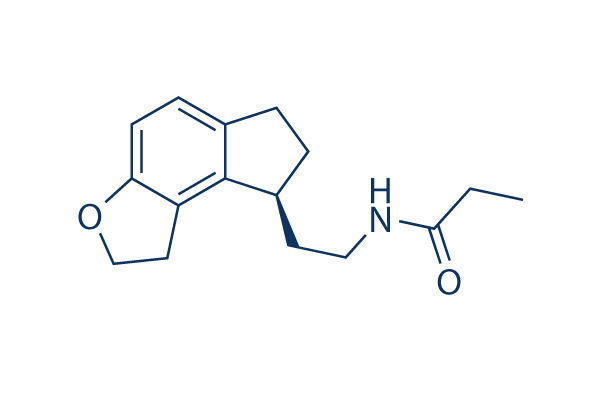| Cas No.: | 196597-26-9 |
| Chemical Name: | (S)-N-[2-(1,6,7,8-Tetrahydro-2H-indeno[5,4-b]furan-8-yl)ethyl]propionamide |
| Synonyms: | TAK-375; Rozerem; TAK375; TAK 375, |
| SMILES: | O=C(NCC[C@H]1C2=C(C=CC3=C2CCO3)CC1)CC |
| Formula: | C16H21NO2 |
| M.Wt: | 259.34 |
| Purity: | >98% |
| Sotrage: | 2 years -20°C Powder, 2 weeks 4°C in DMSO, 6 months -80°C in DMSO |
| Description: | Ramelteon inhibits forskolin-stimulated cAMP production with IC50 of 21.2 pM in CHO cells. Ramelteon has high affinity with recombinant human MT1 and MT2 receptors with pKi of 10.05 and 9.70, respectively. Ramelteon inhibits Xenopus laevis melanophore pigment granule aggregation with pEC50 of 11.48. Ramelteon (1 nM) increases ERK1/2 phosphorylation not only in MT1/MT2 cerebellar granule cells but also in cerebellar granule cells expressing only one of the two melatonin receptors. 4P-PDOT blocks the stimulatory action of Ramelteon (1 nM) in MT1 KO cerebellar granule cells, while luzindole attenuates the action of Ramelteon (1 nM) in MT2 KO cerebellar granule cells. Ramelteon (100 μM) induces any pigment dispersion while melatonin completely disperses aggregated melanophores at 10 μM. Ramelteon (10 mg/kg, i/p) significantly reduces NREM sleep latency in rat and also produces a short-lasting increase in nonrapid eye movement (NREM) sleep duration, but the NREM power spectrum is unaltered. Ramelteon (0.1 mg/kg and 1 mg/kg, p.o.) accelerates reentrainment of running wheel activity rhythm to the new lightdark cycle in rats without affecting learning or memory. Ramelteon (0.03 mg/kg and 0.3 mg/kg, p.o.) significantly shortens latency to sleep onset and significantly increases total duration of sleep in freely moving monkeys without affecting the general behavior of the monkeys. For the detailed information of Ramelteon, the solubility of Ramelteon in water, the solubility of Ramelteon in DMSO, the solubility of Ramelteon in PBS buffer, the animal experiment (test) of Ramelteon, the cell expriment (test) of Ramelteon, the in vivo, in vitro and clinical trial test of Ramelteon, the EC50, IC50,and affinity,of Ramelteon, Please contact DC Chemicals. |

 DC Chemicals' products qualify for U.S. tariff exemptions. We guarantee no price increases due to customs duties and maintain stable supply, continuing to deliver reliable research solutions to our American clients.
DC Chemicals' products qualify for U.S. tariff exemptions. We guarantee no price increases due to customs duties and maintain stable supply, continuing to deliver reliable research solutions to our American clients.





















